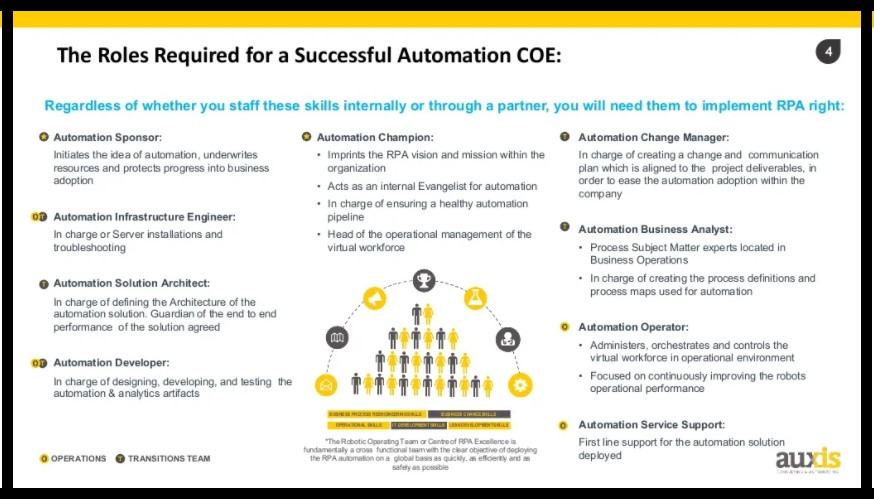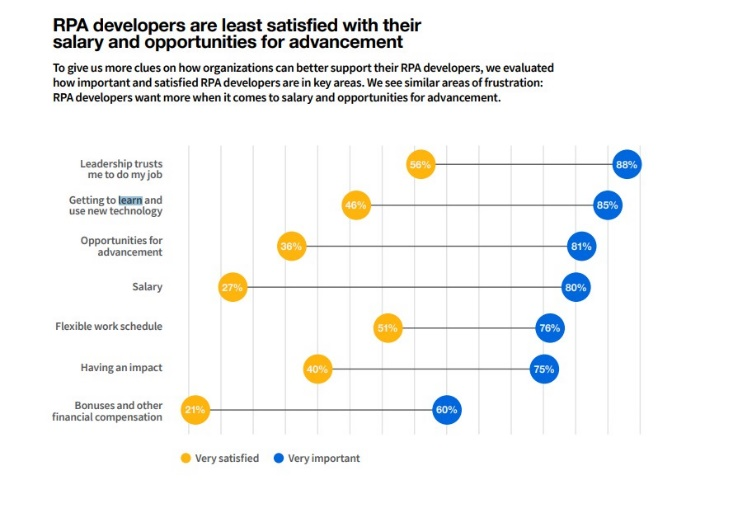Are you struggling to find and retain skilled talent for your Robotic Process Automation (RPA) program? You’re not alone. With the demand for RPA talent skyrocketing, companies are finding it challenging to attract and retain top talent. In this article, we’ll share five best practices for RPA talent management that can help you build a robust talent management strategy and achieve your automation goals.
With Robotic Process Automation (RPA) emerging as one of the fastest-growing software segments in the industry, experienced RPA talent today are essentially the rockstars of IT. The right RPA talent management strategy is vital to recruiting and retaining the people you need to maximize the value of your automation program.
Deloitte reports that 73% of organizations started their RPA journey in 2020 alone, with near universal adoption expected by 2022. Now, enterprises are looking to scale their programs and realize the full value of their investment company-wide.
Such high demand has placed “robotics engineer” among the fastest-growing jobs on LinkedIn in the last couple of years. But while UiPath’s 2022 State of the RPA Developer report found 91% of respondents expect their organizations to hire more RPA developers in the next 12 months, a severe shortage of tech talent nationwide impacts their ability to move forward.
Turnover is alarmingly high in the hot job market, with 78% of RPA developers either actively seeking new jobs or open to new opportunities, UiPath reports. Labor costs are also rising, with the average RPA developer salary surpassing $108,000.
Developers experienced in the market-leading UiPath platform average more than $121,000, ZipRecruiter reports. RPA architects can command even more, with average salaries surpassing $157,000.
Nearly half the attendants at a recent Auxis webinar, “Maximizing the Value of Your UiPath Automation Program,” considered finding and retaining talent their biggest challenge to scaling RPA.
How to build a robust RPA talent management strategy
A robust RPA talent management strategy is integral to creating a CoE that can support the growth and goals of your organization. For a successful RPA journey, you need qualified and cost-effective talent that can create sustainable automation, drive business case creation across many opportunities, collaborate with the business and IT in real-time, and build enthusiasm for automation company-wide.
Here are five best practices for attracting and retaining the RPA talent you need for a successful journey:
1. Don’t combine CoE roles
Whether you ultimately outsource your CoE, staff internally, or create a hybrid solution, a successful program hinges on several key roles. Yet despite very different skill sets and responsibilities, too many companies wrongly assume these jobs can be performed by the same RPA talent – setting their implementation up for failure.

For instance, enterprises often expect RPA developers to also provide support. However, ongoing maintenance and support require a different set of skills than design and implementation. Enterprises also underestimate the time required to ensure a smooth automation program, which distracts developers from higher-value innovation.
Nearly 40% of RPA developers rank maintenance and support among their most-hated job activities, and they don’t have to put up with dissatisfaction in this hot job market!
A separate support structure that can guarantee continuous operation of your bots is key to long-term success. UiPath also offers products like Test Suite and Task Capture that can further increase job satisfaction by automating the menial tasks that developers detest.
2. Focus on salary, career growth, and learning new technologies.
For organizations focused on hiring or retaining RPA talent, the UiPath report ranks what developers care about most – and how organizations measure up:
- 85% view getting to learn and use new technology as “very important,” but only 46% feel “very satisfied” with their current opportunities.
- 81% view opportunities for advancement as “very important,” but only 36% feel satisfied with their potential for promotions.
- 80% prioritize salary, but only 27% are “very satisfied” with their earnings.

3. Consider a hybrid structure for your RPA CoE.
Building and operating an RPA CoE is not a one-size-fits-all endeavor. The right approach boils down to factors like organizational size, demand for the technology, and capabilities of in-house talent.
Not surprisingly, UiPath found that 70% of its customers rely on a partner for their RPA journey. On paper, building an internal CoE may appear less costly than hiring a third party.
In reality, this approach works best for large global organizations with deep pockets and sizable workforces, where even small productivity gains generate significant cost savings. And even those scenarios must contend with the headache of hiring certified RPA developers in a challenging market and figuring out a flexible staffing plan for high-demand situations.
Most enterprises agree that a hybrid model that leverages the RPA talent, knowledge, and experience of a reputable provider with the business expertise of in-house staff ensures the most reliable end-to-end outcome. Organizations with extensive RPA use cases also sometimes opt to retain development but outsource other areas where they lack expertise, like process mining or maintenance and support.
4. Leverage a nearshore solution to source RPA talent.
Top nearshore locations like Costa Rica and Colombia have invested heavily into becoming technology hubs and developing tech talent. For instance, with two of the most prominent tech universities in the region, Costa Rican nearshore providers benefit from a constant flow of skilled IT graduates with cutting-edge expertise that expands the country’s digital labor force by 17% annually.
Costa Rica is so proficient in technology that it is often called the ‘Silicon Valley’ of Latin America. Automation talent at the Auxis RPA Global Center of Excellence in San José have, on an average, more than six years of best-in-class UiPath experience.
With almost half of in-house staff having less than two years of RPA experience, as the UiPath report found, several Auxis clients are leveraging RPA capabilities in Costa Rica, including Vmware, Equifax, Amerant Bank, Baptist Health South Florida, and many more.
Tapping into Costa Rica’s highly proficient talent pool enables enterprises to achieve significant cost savings without sacrificing quality, delivering an average of 30-50% labor arbitrage compared to IT resources in the U.S.
For the cost of an entry-level RPA developer locally, companies can get more experienced resources in Latin America. That experience drives productivity and performance: After implementing hundreds of robots, reputable nearshore teams can guarantee more rapid deployment of robots with fewer errors and less rework than less-experienced U.S. teams.
Nearshoring to Latin America also resolves many pain points of Asia-based offshore solutions that undercut the speed, synergies, and responsiveness essential to RPA implementations. That includes the difficulty of doing business across distant time zones, language and cultural barriers, and the more competitive IT market in countries like India driving extremely high turnover and salaries that can negate offshore savings.
5. Learn best practices for upskilling employees in RPA.
Despite RPA’s rapid growth, 66% of employees have never heard of the technology, a Bain/UiPath survey found. But once they do, 86% cite a high willingness to use it.
As automation takes over menial tasks, there is a huge opportunity for building communications programs and excitement that can drive valuable employees looking for new roles toward RPA.
UiPath Academy offers dozens of free on-demand courses in its training platform to teach automation skills to employees at scale. Whether they want to become developers or business analysts in the CoE, or join the citizen-led development movement aimed at creating a robot for every person, upskilling helps enterprises accelerate RPA adoption company-wide.
Encouraging employees to build skill specialization creates the biggest benefits. With UiPath constantly adding innovations to its platform, it’s impossible to become an expert in every product.
Developing talent with deep expertise in niche areas like Long Running Workflows or Document Understanding leads to high-quality automation that can scale. With high demand for each new product, specialization also helps employees develop coveted skill sets.
Of course, upskilling involves time and financial costs, and many companies find that tapping an experienced UiPath partner is a better way to roll out new solutions quickly and reliably. Taking advantage of a partner’s expertise also enables enterprises to ensure new products make sense for their business before investing in internal training.
Nearshoring helps U.S. enterprises beat the RPA talent shortage
Valued at $2.039 billion in 2020, the RPA market is expected to expand at an impressive 31.5% CAGR through 2026 as enterprises embrace automation as integral to the future of work. But the severe RPA talent shortage in the U.S. makes it difficult to realize the full value of automation – and stalls many programs altogether.
Implementing the best practices for talent management is vital to building a reliable CoE. Combining in-house and nearshore resources is a proven strategy in this challenging market – providing instant access to experienced, affordable talent while benefiting from the collaboration and higher quality that comes from working under the same time zone as the U.S.
Nearshoring also shifts the burden of recruiting and retaining talent to your partner, letting you stay focused on innovation and strategy.
To learn more effective strategies for building a high-quality UiPath Automation CoE, and discover how other U.S. enterprises are navigating the RPA talent shortage, watch our webinar, “Maximizing the Value of Your UiPath Automation Program.”




